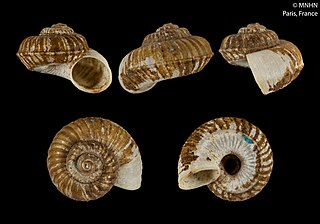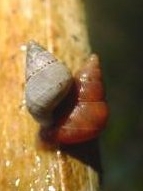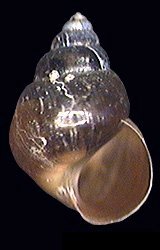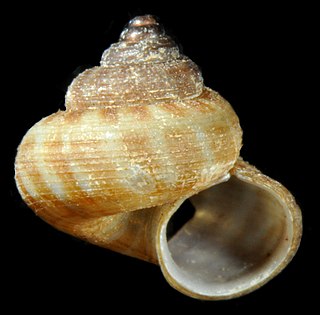
Cyathopoma is a genus of land snails with an operculum, a terrestrial gastropod mollusks in the family Cyclophoridae.

Omphalotropis is a genus of minute salt marsh snails with an operculum, terrestrial gastropod mollusks in the subfamily Omphalotropidinae of the family Assimineidae.

Tropidophora is a genus of land snails with an operculum, terrestrial gastropod mollusks in the family Pomatiidae.

Assimineidae is a family of minute snails, also known as palmleaf snails, with an operculum, gastropod mollusks or micromollusks in the superfamily Rissoidae. Many of these very small snails live in intermediate habitats, being amphibious between saltwater and land; others live in freshwater.

Diplommatinidae is a family of small land snails, also known as staircase snails, with an operculum, terrestrial gastropod mollusks in the superfamily Cyclophoroidea. The Cochlostomatinae Kobelt, 1902, were previously considered a subfamily of the Diplommatinidae, but are now known to be a separate family.

Cyclophoroidea is a superfamily of land snails with an operculum, terrestrial gastropods within the informal group Architaenioglossa, that belongs to the clade Caenogastropoda.

Pupinidae is a taxonomic family of land snails with an operculum, terrestrial gastropod mollusks in the superfamily Cyclophoroidea.

Megalomastomatidae is a family of tropical land snails with an operculum, terrestrial gastropod mollusks in the superfamily Cyclophoroidea.

Neocyclotidae is a family of tropical land snails with gills and an operculum, terrestrial gastropod mollusks in the informal group Architaenioglossa belonging to the clade Caenogastropoda.

The family Pomatiidae is a taxonomic family of small operculate land snails, terrestrial gastropod mollusks that can be found over the warmer parts of the Old World. In the older literature, this family is designated as Pomatiasidae.

Cyclophorus is a genus of operculate land snails, terrestrial gastropod mollusks in the family Cyclophoridae.

Cyclotus is a genus of tropical land snails in the subfamily Cyclophorinae of the family Cyclophoridae.

Lagocheilus is a genus of gastropods in the family Cyclophoridae.

Pterocyclos is a genus of tropical land snails in the subfamily Cyclophorinae of the family Cyclophoridae.

Scabrina is a genus of operculate land snails, terrestrial gastropod mollusks in the subfamily Cyclophorinae of the family Cyclophoridae.















